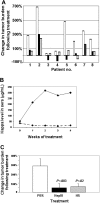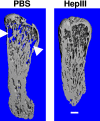The syndecan-1 heparan sulfate proteoglycan is a viable target for myeloma therapy
- PMID: 17536013
- PMCID: PMC1976367
- DOI: 10.1182/blood-2007-04-082495
The syndecan-1 heparan sulfate proteoglycan is a viable target for myeloma therapy
Abstract
The heparan sulfate proteoglycan syndecan-1 is expressed by myeloma cells and shed into the myeloma microenvironment. High levels of shed syndecan-1 in myeloma patient sera correlate with poor prognosis and studies in animal models indicate that shed syndecan-1 is a potent stimulator of myeloma tumor growth and metastasis. Overexpression of extracellular endosulfatases, enzymes which remove 6-O sulfate groups from heparan sulfate chains, diminishes myeloma tumor growth in vivo. Together, these findings identify syndecan-1 as a potential target for myeloma therapy. Here, 3 different strategies were tested in animal models of myeloma with the following results: (1) treatment with bacterial heparinase III, an enzyme that degrades heparan sulfate chains, dramatically inhibited the growth of primary tumors in the human severe combined immunodeficient (SCID-hu) model of myeloma; (2) treatment with an inhibitor of human heparanase, an enzyme that synergizes with syndecan-1 in promoting myeloma progression, blocked the growth of myeloma in vivo; and (3) knockdown of syndecan-1 expression by RNAi diminished and delayed myeloma tumor development in vivo. These results confirm the importance of syndecan-1 in myeloma pathobiology and provide strong evidence that disruption of the normal function or amount of syndecan-1 or its heparan sulfate chains is a valid therapeutic approach for this cancer.
Figures





Similar articles
-
The heparanase/syndecan-1 axis in cancer: mechanisms and therapies.FEBS J. 2013 May;280(10):2294-306. doi: 10.1111/febs.12168. Epub 2013 Mar 4. FEBS J. 2013. PMID: 23374281 Free PMC article. Review.
-
Shed syndecan-1 translocates to the nucleus of cells delivering growth factors and inhibiting histone acetylation: a novel mechanism of tumor-host cross-talk.J Biol Chem. 2015 Jan 9;290(2):941-9. doi: 10.1074/jbc.M114.608455. Epub 2014 Nov 17. J Biol Chem. 2015. PMID: 25404732 Free PMC article.
-
Heparanase enhances syndecan-1 shedding: a novel mechanism for stimulation of tumor growth and metastasis.J Biol Chem. 2007 May 4;282(18):13326-33. doi: 10.1074/jbc.M611259200. Epub 2007 Mar 8. J Biol Chem. 2007. PMID: 17347152
-
SST0001, a chemically modified heparin, inhibits myeloma growth and angiogenesis via disruption of the heparanase/syndecan-1 axis.Clin Cancer Res. 2011 Mar 15;17(6):1382-93. doi: 10.1158/1078-0432.CCR-10-2476. Epub 2011 Jan 21. Clin Cancer Res. 2011. PMID: 21257720 Free PMC article.
-
Heparan sulfate proteoglycans and heparanase--partners in osteolytic tumor growth and metastasis.Matrix Biol. 2004 Oct;23(6):341-52. doi: 10.1016/j.matbio.2004.08.004. Matrix Biol. 2004. PMID: 15533755 Review.
Cited by
-
The heparanase/syndecan-1 axis in cancer: mechanisms and therapies.FEBS J. 2013 May;280(10):2294-306. doi: 10.1111/febs.12168. Epub 2013 Mar 4. FEBS J. 2013. PMID: 23374281 Free PMC article. Review.
-
Involvement of heparanase in atherosclerosis and other vessel wall pathologies.Matrix Biol. 2013 Jun 24;32(5):241-51. doi: 10.1016/j.matbio.2013.03.002. Epub 2013 Mar 13. Matrix Biol. 2013. PMID: 23499530 Free PMC article. Review.
-
Syndecan-1 promotes the angiogenic phenotype of multiple myeloma endothelial cells.Leukemia. 2012 May;26(5):1081-90. doi: 10.1038/leu.2011.290. Epub 2011 Oct 25. Leukemia. 2012. PMID: 22024722 Free PMC article.
-
Non-Anticoagulant Heparins Are Hepcidin Antagonists for the Treatment of Anemia.Molecules. 2017 Apr 8;22(4):598. doi: 10.3390/molecules22040598. Molecules. 2017. PMID: 28397746 Free PMC article. Review.
-
N-glycosylation of serum proteins for the assessment of patients with IgD multiple myeloma.BMC Cancer. 2017 Dec 21;17(1):881. doi: 10.1186/s12885-017-3891-3. BMC Cancer. 2017. PMID: 29268706 Free PMC article.
References
-
- Ridley RC, Xiao HQ, Hata H, Woodliff J, Epstein J, Sanderson RD. Expression of syndecan regulates human myeloma plasma cell adhesion to type I collagen. Blood. 1993;81:767–774. - PubMed
-
- Wijdenes J, Vooijs WC, Clement C, et al. A plasmocyte selective monoclonal antibody (B-B4) recognizes syndecan-1. Br J Haematol. 1996;94:318–323. - PubMed
-
- Bayer-Garner IB, Sanderson RD, Dhodapkar MV, Owens RB, Wilson CS. Syndecan-1 (CD138) immunoreactivity in bone marrow biopsies of multiple myeloma: shed syndecan-1 accumulates in fibrotic regions. Mod Pathol. 2001;14:1052–1058. - PubMed
-
- Dhodapkar MV, Kelly T, Theus A, Athota AB, Barlogie B, Sanderson RD. Elevated levels of shed syndecan-1 correlate with tumour mass and decreased matrix metalloproteinase-9 activity in the serum of patients with multiple myeloma. Br J Haematol. 1997;99:368–371. - PubMed
-
- Seidel C, Sundan A, Hjorth M, et al. Serum syndecan-1: a new independent prognostic marker in multiple myeloma. Blood. 2000;95:388–392. - PubMed
Publication types
MeSH terms
Substances
Grants and funding
LinkOut - more resources
Full Text Sources
Other Literature Sources
Medical
Miscellaneous

